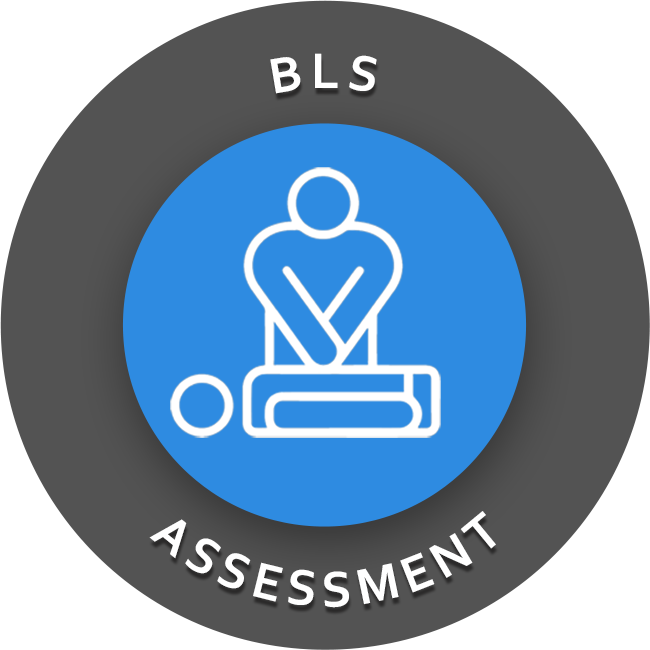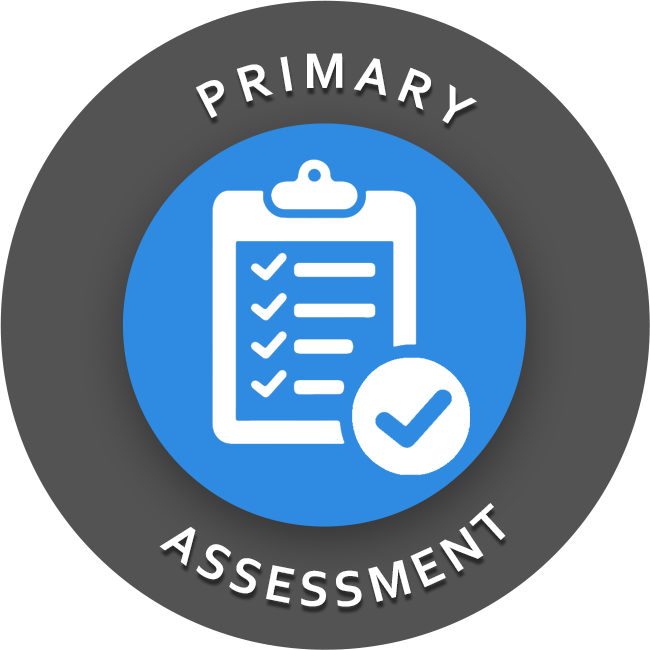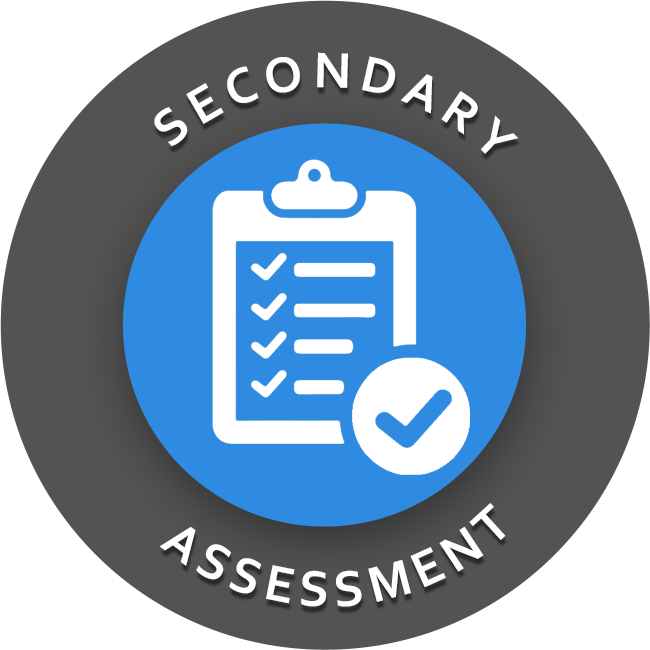
BLS Assessment
Foundational to every ACLS Algorithm is the BLS Assessment. The BLS Assessment is the first step that you will take when treating any emergency situation, and there are 4 main assessment steps to remember.
This is an outline of the 4 steps in the BLS Assessment :
(1) Check responsiveness by tapping and shouting, “Are you all right?” Scan the patient for absent or abnormal breathing (scan 5-10 seconds).
(2) Activate the emergency response system and obtain a AED. If there is more than one rescuer, have the second person activate emergency response and get the AED/Defibrillator.
(3) Circulation: Check for a carotid pulse. This pulse check should not take more than 5-10 seconds. If no pulse is palpable begin CPR.
(4) Defibrillation: If there is no pulse, check for a shockable rhythm with the AED or defibrillator as soon as it arrives. Follow the instructions provided by the AED or begin ACLS Protocol.
For a more in-depth review of BLS refer to the American Heart Association’s BLS Provider Manual.
Remember to assess first then perform appropriate actions, and after each action…reassess.

Primary Assessment for ACLS
The Primary Assessment uses the ABCDE model to systematize the assessment process. The ABCDE’s of the Primary Assessment are:
(A) Airway: Maintain airway and use advanced airway if needed. Ensure confirmation of placement of an advanced airway and secure the advanced airway device.
(B) Breathing: Give bag-mask ventilation, provide supplemental oxygen, and avoid excessive ventilation. Also, adequacy of ventilation and oxygenation should be monitored during this step.
(C) Circulation: Obtain IV access, attach ECG leads, identify and monitor arrhythmias, giving fluids if needed, and use defibrillation if appropriate.
(D) Disability: Perform a general neurological assessment which should include assessment of responsiveness, level of consciousness, and pupil reflex. AVPU acronym may help. (Alert, Voice, Painful, Unresponsive)
(E)Exposure: Ensure that clothing is removed so that a complete visual assessment can be performed. This visual assessment should include looking for signs of trauma, bleeding, burns, or medical alert bracelets.
The Primary Assessment is included in every ACLS algorithm and like the BLS Assessment, it helps to systematize the resuscitation process and improve patient outcomes.

Secondary Assessment for ACLS
The secondary assessment includes a search for underlying causes for the emergency and if possible a focused medical history. This search for for underlying causes, also known as differential diagnosis, requires a review of all of the H’s and T’s of ACLS. Visit H’s and T’s page for a full review.
Performing the focused medical history can be simplified using the acronym SAMPLE. (S)Signs and symptoms; (A)Allergies; (M)Medications; (P)Past Illnesses; (L)Last Oral Intake; (E)Events Leading Up To Present Illness.
Use the links to the left for further details of ACLS Protocol and specific interventions in each ACLS algorithm.
The objective of the review of these ACLS Algorithms is to help prepare you for the ACLS written test and the ACLS Megacode. After reviewing, you can test your skills and knowledge by accessing the ACLS Megacode Simulator and ACLS practice exams.
steveahm@comcast.net says
Hi Jeff, Good Day! I have a question, and it pertains to the Systematic Approach module/process. Specifically, the question relates to the patient “disability”/neuro status. My question is that in some places, the D within the ALS survey confers to “Disability”, and in others in confers search for “Differential Diagnosis”. I have gone through this process approx 20 times in my career, and I seem to recall at one point, the issues were coupled together under the ALS survey. in “D”. I know there is a new wide emphasis on differential diagnosis, particularly as it pertains to treating PEA. Just want to be sure I work it in, though I know I would be prompted if I didn’t. Again, you are a nurse sports star for all the help that you have given us all through the years. BEST!
ACLS says
Honestly, the American heart Association acronyms can be confusing because they change them regularly.
The D for defibrillation is used for the BLS assessment.
The D within ACLS stands for disability and is used within the primary assessment.
They are not coupled together.
Kind regards,
Jeff
Van Nguyen says
I was going through the interactive videos through American Heart and getting things wrong. I knew then, that I had to go back to basics and review. I’ve used this site before, and it really helped me to learn. Taking the quizzes here and reading the answers was so much more interesting than simply reading a book. Thank you.
ACLS says
That’s great. Thanks for letting me know that things helped. Thank you for leaving feedback. Kind regards, Jeff
Joseph Cloud says
I have been taking the ACLS certification since 1997. I never,ever pay for review sites. However found this site, and was surfing through it. I had no trouble putting out some cash for this informative site. Thanks for making my review simple.
PETER REINIER FELICIANO says
Hi Jeff,
I have several questions mate:
1. In dealing with patients with a hump (Kyphosis), how do you perform High quality chest compression then?
2. Is consent necessary for severe choking patients?
3. If an EMS team found that cessation of CPR is the only option for a patient, who is legally bound to declare that the ‘patient is dead.’ Should they phone a doctor? or should they just write the time of death and address it to the practitioner at a later time.
Sincerely,
Peter Feliciano
Jeff with admin. says
Question 1:
You will perform chest compressions to the best of your abilities. Situations where there are physical abnormalities can complicated positive outcomes. If you have waveform capnography capabilities you can monitor the quality of your chest compressions. This would be one way to hopefully overcome the physical abnormalities by adjusting continuously to you’re reading on the capnography monitor. The patient would need to be intubated for capnography monitoring to be an option.
Question 2:
Consent is not necessary for the choking victim. Most countries have laws to protect good samaritans who have proper training that provide CPR and other life-support skills like the Heimlich maneuver.
Question 3:
Typically, in the hospital setting, a physician is required to pronounce a patient deceased. Usually paramedics and other EMS providers will be communicating with the dispatch that will give them guidance as well.
Kind regards,
Jeff
Clem Stalcup says
I have been doing ACLS since 1990. This site is an amazing find. This is the second recertification I have used this site to review for . Thanks so much. An amazing tool..
chidichimoc says
Thanks Jeff for this site. It is fantastic. I’m studying to became ACLS instructor.
Thank a lot for topics, videos and questions and your comments.
Tracey Miller says
This even sounds ridiculous to me but I’ll bring it up anyway!
Obviously BLS before ACLS, in BLS the AHA manual states
C: circulation; A: airway; B: breathing as a way to remember the steps but when you read the systematic approach, “BLS Assessment is the First step in treating an Emergency-
4 main assessment steps to remember”…
1. Check responsiveness
2. Activate EMS & get AED
3. Circulation
4. Defib
What happened to the ” C-A-B” ?
Its where they “kinda Trick you” in the tests…
Also, realizing of course, you’re not going to just run up to someone & just start doing Compressions before you ask if they’re OK !
Sorry its kinda silly but curious your answer/thoughts!
Thanks,
Tracey
Jeff with admin. says
C-A-B has to do with the assessment actions that are carried out during BLS.
C-Circulation is the first assessment that is performed.
If there is circulation then the A-Airway is assessed for being open and clear.
When and open and clear airway is established, then B-breathing is assessed.
This CAB sequence ensures that CPR begins as quickly as possible. If there is no pulse (C-circulation) then CPR begins immediately.
Does that make sense? Please let me know if you have any other questions.
Kind regards,
Jeff
Joel Mwafongo says
This site is useful
Soichan Mathew says
In this topic BLS assessment,Primary assessment and secondary assessment picture is there.video cannot open
Jeff with admin. says
There is no video associated with this page. Kind regards, Jeff
Silvia Moshi says
can someone remind me of H’s and T’s of acls please
Jeff with admin. says
Here’s a page that covers all of that information:
H’s and T’s of ACLS
pamela mccarty says
Jeff, Third re-certification! I always come here first. This is the best study guide a person could ask for. Agreed, the website gets better and better. Pam
Jeffrey Johnson says
Just getting started again (4th recertification) and this site just keeps getting better. Thanks Jeff for making this so practical and enjoyable.
Jeff with admin. says
You are very welcome! Kind regards, Jeff
Tia Moser says
Love this site
Dolores Sy says
Very good topics for ACLS review.